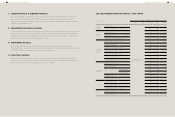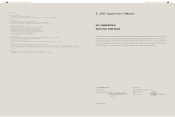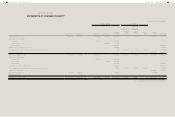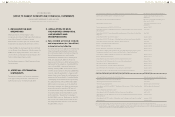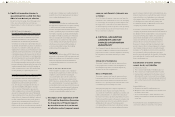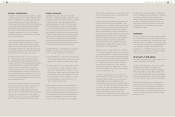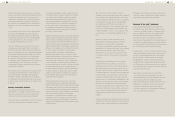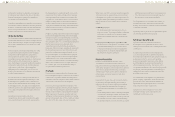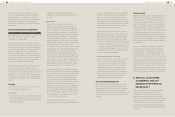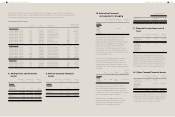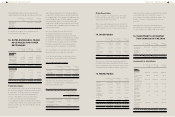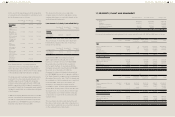HTC 2013 Annual Report Download - page 95
Download and view the complete annual report
Please find page 95 of the 2013 HTC annual report below. You can navigate through the pages in the report by either clicking on the pages listed below, or by using the keyword search tool below to find specific information within the annual report.
FINANCIAL INFORMATION FINANCIAL INFORMATION
186 187
Business Combinations
Acquisitions of businesses are accounted for using the
acquisition method. The consideration transferred in a
business combination is measured at fair value, which
is calculated as the sum of the acquisition-date (i.e.,
the day when the Company obtains control) fair values
of the assets transferred by the Company, liabilities
incurred by the Company to the former owners of
the acquiree and the equity interests issued by the
Company in exchange for control of the acquiree.
Acquisition-related costs are generally recognized in
profit or loss as incurred.
At the acquisition date, the identifiable assets
acquired and the liabilities assumed are recognized
at their fair value, except that deferred tax assets or
liabilities, and assets or liabilities related to employee
benefit arrangements are recognized and measured
in accordance with IAS 12 "Income Taxes" and IAS 19
"Employee Benefits respectively", respectively.
Goodwill is measured as the excess of the sum of
the consideration transferred and the fair value of
the acquirer's previously held equity interest in the
acquiree over the net of the acquisition-date amounts
of the identifiable assets acquired and the liabilities
assumed. If, after re-assessment, the net of the
acquisition-date amounts of the identifiable assets
acquired and liabilities assumed exceeds the sum of
the consideration transferred and the fair value of the
acquirer's previously held interest in the acquiree, the
excess is recognized immediately in profit or loss as a
gain from bargain purchase.
Non-controlling interests that are present ownership
interests and entitle their holders to a proportionate
share of the entity's net assets in the event of
liquidation may be initially measured either at fair
value or at the non-controlling interests' proportionate
share of the recognized amounts of the acquiree's
identifiable net assets. The choice of measurement
basis is made on a transaction-by-transaction basis.
directly in other comprehensive income, in which case,
the exchange differences are also recognized directly
in other comprehensive income.
For the purposes of presenting parent company only
financial statements, the assets and liabilities of the
Company's foreign operations are translated into New
Taiwan dollars using exchange rates prevailing at the
end of each reporting period. Income and expense
items are translated at the average exchange rates for
the period, unless exchange rates fluctuate significantly
during that period, in which case the exchange rates
at the dates of the transactions are used. Exchange
differences arising, if any, are recognized in other
comprehensive income and accumulated in equity
(attributed to the owners of the Company and non-
controlling interests as appropriate).
On the disposal of a foreign operation (i.e. a disposal
of the Company's entire interest in a foreign operation,
or a disposal involving loss of control over a subsidiary
that includes a foreign operation, a disposal involving
loss of joint control over a jointly controlled entity that
includes a foreign operation, or a disposal involving
loss of significant influence over an associate that
includes a foreign operation), all of the exchange
differences accumulated in equity in respect of that
operation attributable to the owners of the Company
are reclassified to profit or loss.
In relation to a partial disposal of a subsidiary that
does not result in the Company losing control over the
subsidiary, the proportionate share of accumulated
exchange differences are re-attributed to non-
controlling interests and are not recognized in profit or
loss. For all other partial disposals (i.e. partial disposals
of associates or jointly controlled entities that do not
result in the Company losing significant influence
or joint control), the proportionate share of the
accumulated exchange differences recognized in other
comprehensive income is reclassified to profit or loss.
Foreign Currencies
In preparing the parent company only financial
statements of each individual group entity, transactions
in currencies other than the entity's functional currency
(foreign currencies) are recognized at the rates of
exchange prevailing at the dates of the transactions.
Functional currency is the currency of the primary
economic environment in which the entity operates.
At the end of each reporting period, monetary items
denominated in foreign currencies are retranslated at
the rates prevailing at that date. Non-monetary items
carried at fair value that are denominated in foreign
currencies are retranslated at the rates prevailing at
the date when the fair value was determined. Non-
monetary items that are measured in terms of historical
cost in a foreign currency are not retranslated.
Exchange differences on monetary items arising from
settlement or translation are recognized in profit or
loss in the period in which they arise except for:
a. Exchange differences on transactions entered into in
order to hedge certain foreign currency risks (please
refer to Note 4 "Hedge accounting" section); and
b. Exchange differences on monetary items receivable
from or payable to a foreign operation for which
settlement is neither planned nor likely to occur in
the foreseeable future (therefore forming part of the
net investment in the foreign operation), which are
recognized initially in other comprehensive income
and reclassified from equity to profit or loss on
disposal of the net investments.
Exchange differences arising on the retranslation of
non-monetary assets (such as equity instruments) or
liabilities measured at fair value are included in profit
or loss for the period at the rates prevailing at the end
of reporting period except for exchange differences
arising on the retranslation of non-monetary items
in respect of which gains and losses are recognized
Goodwill and fair value adjustments on identifiable
assets and liabilities acquired arising on the acquisition
of a foreign operation are treated as assets and
liabilities of the foreign operation and translated at
the rate of exchange prevailing at the end of each
reporting period. Exchange differences arising are
recognized in other comprehensive income and
accumulated in equity.
Inventories
Inventories consist of raw materials, supplies, finished
goods and work-in-process and are stated at the lower
of cost or net realizable value. Inventory write-downs
are made by item, except where it may be appropriate
to group similar or related items. Net realizable value
is the estimated selling price of inventories less all
estimated costs of completion and costs necessary to
make the sale. Inventories are recorded at weighted-
average cost on the balance sheet date.
Investments in Subsidiaries
Subsidiaries (including special purpose entities) are the
entities controlled by the Company.
Under the equity method, the investment is initially
recognized at cost and the carrying amount is
increased or decreased to recognize the Company's
share of the profit or loss and other comprehensive
income of the subsidiary after the date of acquisition.
Besides, the Company also recognizes the Company's
share of the change in other equity of the subsidiary
.
Changes in the Company's ownership interests in
subsidiaries that do not result in the Company's loss
of control over the subsidiaries are accounted for
as equity transactions. Any difference between the
carrying amounts of the investment and the fair value
of the consideration paid or received is recognized
directly in equity.



